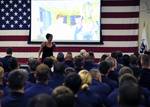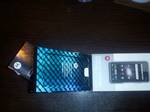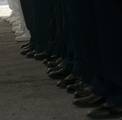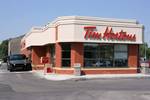- go to the top
- About WN
- Contact
- Feedback
- Privacy Policy
- © 2011 World News Inc., all Rights Reserved
-
Abbie Hoffman

Abbot Howard "Abbie" Hoffman (November 30, 1936 – April 12, 1989) was an American social and political activist who co-founded the Youth International Party ("Yippies").
http://wn.com/Abbie_Hoffman -
Anthony Stockholm
Anthony Stockholm was the first president of the New York Stock Exchange from 1817 to 1818.
http://wn.com/Anthony_Stockholm -
George B. Post

George Browne Post (December 15, 1837 – November 28, 1913) was an American architect trained in the Beaux-Arts tradition.
http://wn.com/George_B_Post -
George W. Bush

George Walker Bush (; born July 6, 1946, in New Haven, Connecticut) was the 43rd President of the United States, serving from 2001 to 2009, and the 46th Governor of Texas, serving from 1995 to 2000.
http://wn.com/George_W_Bush -
John S. Reed
John Shepard Reed (born 1939) is the former Chairman of the New York Stock Exchange. He previously served as Chairman and CEO of Citicorp, Citibank, and post-merger, Citigroup.
http://wn.com/John_S_Reed -
Michael Moore

Michael Francis Moore (born April 23, 1954) is an American filmmaker, author and liberal political commentator. He is the director and producer of Bowling for Columbine, Fahrenheit 9/11, Sicko, and , four of the top nine highest-grossing documentaries of all time. In September 2008, he released his first free movie on the Internet, Slacker Uprising, documenting his personal crusade to encourage more Americans to vote in presidential elections. He has also written and starred in the TV shows TV Nation and The Awful Truth.
http://wn.com/Michael_Moore -
Piccirilli Brothers

The Piccirilli Brothers were a family of renowned marble carvers who carved a large number of the most significant marble sculptures in the United States, including Daniel Chester French’s colossal Abraham Lincoln (1920) in the Lincoln Memorial, Washington, D.C.
http://wn.com/Piccirilli_Brothers -
Scott Altman

Captain Scott Douglas "Scooter" Altman, USN, (born 15 August 1959) is a test pilot and NASA astronaut and veteran of four space shuttle missions. His fourth space shuttle mission on STS-125 was the last servicing mission to the Hubble Space Telescope.
http://wn.com/Scott_Altman -
World War I

World War I was a military conflict centered on Europe that began in the summer of 1914. The fighting ended in late 1918. This conflict involved all of the world's great powers, assembled in two opposing alliances: the Allies (centred around the Triple Entente) and the Central Powers. More than 70 million military personnel, including 60 million Europeans, were mobilized in one of the largest wars in history. More than 9 million combatants were killed, due largely to great technological advances in firepower without corresponding ones in mobility. It was the second deadliest conflict in history.
http://wn.com/World_War_I
-
Lower Manhattan

Lower Manhattan is the southernmost part of the island of Manhattan, the main island and center of business and government of the City of New York. Lower Manhattan or "downtown" is defined most commonly as the area delineated on the north by 14th Street, on the west by the Hudson River, on the east by the East River, and on the south by New York Harbor (also known as Upper New York Bay). When referring specifically to the lower Manhattan business district and its immediate environs, the northern border is commonly designated by thoroughfares approximately a mile-and-a-half south of 14th Street and a mile north of the island's southern tip: Chambers Street from near the Hudson east to the Brooklyn Bridge entrances and overpass. Two other major arteries are also sometimes identified as the northern border of "lower" or "downtown Manhattan": Canal Street, roughly half a mile north of Chambers Street, and 23rd Street, roughly half a mile north of 14th Street. Anchored by Wall Street, in Lower Manhattan, New York City is the financial capital of the world and is home to the New York Stock Exchange, the world's largest stock exchange by market capitalization of its listed companies.
http://wn.com/Lower_Manhattan -
Wall Street

Wall Street is a street in Lower Manhattan, New York City. It runs east from Broadway to South Street on the East River, through the historical center of the Financial District. It is the first permanent home of the New York Stock Exchange, the world's largest stock exchange by market capitalization of its listed companies. Over time, Wall Street became the name of the surrounding geographic neighborhood and also shorthand (or a metonym) for the "influential financial interests" of the American financial industry, which is centered in the New York City area. Anchored by Wall Street, New York City vies with the City of London to be the financial capital of the world.
http://wn.com/Wall_Street
- Anthony Stockholm
- ArcaEx
- astronaut
- Black Monday (1987)
- Bond (finance)
- Buttonwood Agreement
- buttonwood tree
- CNN Money
- computer screen
- Corinthian capital
- Decimalisation
- Deutsche_Börse
- DJIA
- Donald L. Evans
- Duncan Niederauer
- Euronext
- Exchange Place
- George B. Post
- George W. Bush
- Green Left Weekly
- hybrid market
- Inflation
- Jack Womack
- John S. Reed
- John Thain
- JPMorgan Chase & Co.
- junk bond
- Lower Manhattan
- market trends
- Michael Moore
- Mike Massimino
- MTV News
- naked short selling
- neoclassic design
- NYSE
- NYSE Arca
- NYSE Composite
- NYSE Composite Index
- NYSE Euronext
- NYSE Group
- open outcry
- Panic of 1873
- Panic of 1907
- Piccirilli Brothers
- Roaring Twenties
- S&P; 500
- Scott Altman
- Share (finance)
- short selling
- stock
- stock broker
- Stock exchange
- Trader (finance)
- Trading curb
- trading halt
- Trading room
- United Airlines
- USA Today
- Wall Street
- Wall Street Bombing
- World War I
- Yippie
Arne Hiorth - Helge Nysted
Releases by year: 2006 |
Releases by album:
Snø |
Album releases
Snø
(Released 2006)
-
Stille Natt
-
Have Yourself A Merry Little Christmas
-
A Child Is Born
-
Julekveldsvise
-
When You Wish Upon A Star
-
God rest Ye Merry Gentelemen
-
Kimer i klokker
-
The Christmas Song
-
En krybbe var vuggen
-
Mitt hjerte alltid vanker
-
Epilog: Romjulsdrøm Bella Notte

- Order: Reorder
- Duration: 2:04
- Published: 02 Oct 2011
- Uploaded: 19 Dec 2011
- Author: TheAnonMessage


- Order: Reorder
- Duration: 10:44
- Published: 22 Dec 2009
- Uploaded: 15 Oct 2011
- Author: AffinityTradingGroup

- Order: Reorder
- Duration: 3:10
- Published: 25 Oct 2008
- Uploaded: 04 Dec 2011
- Author: stockmarketusa





- Order: Reorder
- Duration: 3:11
- Published: 24 Oct 2008
- Uploaded: 20 Dec 2011
- Author: ramonjgoni




- Order: Reorder
- Duration: 1:53
- Published: 17 Nov 2011
- Uploaded: 27 Nov 2011
- Author: ReutersVideo


- Order: Reorder
- Duration: 4:27
- Published: 10 Sep 2011
- Uploaded: 15 Dec 2011
- Author: PBSNewsHour


- Order: Reorder
- Duration: 2:03
- Published: 16 Sep 2010
- Uploaded: 17 Oct 2011
- Author: proukraine

- Order: Reorder
- Duration: 1:43
- Published: 21 Feb 2011
- Uploaded: 19 Apr 2011
- Author: AddisonMichael



size: 1.7Kb
- Abbie Hoffman
- Anthony Stockholm
- ArcaEx
- astronaut
- Black Monday (1987)
- Bond (finance)
- Buttonwood Agreement
- buttonwood tree
- CNN Money
- computer screen
- Corinthian capital
- Decimalisation
- Deutsche_Börse
- DJIA
- Donald L. Evans
- Duncan Niederauer
- Euronext
- Exchange Place
- George B. Post
- George W. Bush
- Green Left Weekly
- hybrid market
- Inflation
- Jack Womack
- John S. Reed
- John Thain
- JPMorgan Chase & Co.
- junk bond
- Lower Manhattan
- market trends
- Michael Moore
- Mike Massimino
- MTV News
- naked short selling
- neoclassic design
- NYSE
- NYSE Arca
- NYSE Composite
- NYSE Composite Index
- NYSE Euronext
- NYSE Group
- open outcry
- Panic of 1873
- Panic of 1907
- Piccirilli Brothers
- Roaring Twenties
- S&P; 500
- Scott Altman
- Share (finance)
- short selling
- stock
- stock broker
- Stock exchange
- Trader (finance)
- Trading curb
- trading halt
- Trading room
- United Airlines
- USA Today
- Wall Street
size: 0.7Kb
size: 2.8Kb
size: 2.3Kb
size: 0.8Kb
size: 2.4Kb
size: 7.7Kb
size: 5.1Kb
size: 5.4Kb
size: 3.8Kb
| Name | New York Stock Exchange |
|---|---|
| Logo | |
| Type | Stock exchange |
| City | New York City |
| Country | United States |
| Foundation | March 8, 1817 |
| Owner | NYSE Euronext |
| Key people | Duncan L. Niederauer (CEO) |
| Currency | United States dollar |
| Listings | 2,317 |
| Mcap | US$13.39 trillion (Dec 2010) |
| Volume | US$1439 billion (Nov 2010) |
| Indexes | NYSE CompositeDow Jones Industrial AverageS&P; 500 |
| Homepage | nyse.com {{Infobox NRHP | embed yes | nrhp_type nhl | image New York Stock Exchange Simon Fieldhouse.jpg | caption Front Elevation of New York Stock Exchange | lat_degrees 40 | lat_minutes 42 | lat_seconds 24.6 | lat_direction N | long_degrees 74 | long_minutes 0 | long_seconds 39.7 | long_direction W | coord_parameters region:US-NY_type:landmark | coord_display inline, title |locmapin New York City | area | built 1903 | architect Trowbridge & Livingston; George B. Post | architecture Classical Revival | designated_nrhp_type June 2, 1978 | added June 2, 1978 | governing_body Private | refnum78001877 }} |
The New York Stock Exchange (NYSE) is a stock exchange located at 11 Wall Street in Lower Manhattan, New York City, USA. It is by far the world's largest stock exchange by market capitalization of its listed companies at 13.39 trillion as of Dec 2010. Average daily trading value was approximately 153 billion in 2008.
The NYSE is operated by NYSE Euronext, which was formed by the NYSE's 2007 merger with the fully electronic stock exchange Euronext. The NYSE trading floor is located at 11 Wall Street and is composed of four rooms used for the facilitation of trading. A fifth trading room, located at 30 Broad Street, was closed in February 2007. The main building, located at 18 Broad Street, between the corners of Wall Street and Exchange Place, was designated a National Historic Landmark in 1978, as was the 11 Wall Street building.
History
The origin of the NYSE can be traced to May 17, 1792, when the Buttonwood Agreement was signed by 24 stock brokers outside of 68 Wall Street in New York under a buttonwood tree on Wall Street. On March 8, 1817, the organization drafted a constitution and renamed itself the "New York Stock & Exchange Board." Anthony Stockholm was elected the Exchange's first president.
The first central location of the Exchange was a room, rented in 1792 for $200 a month, located at 40 Wall Street. After that location was destroyed in the Great Fire of New York in 1835, the Exchange moved to a temporary headquarters. In 1863, the New York Stock & Exchange Board changed to its current name, the New York Stock Exchange. In 1865, the Exchange moved to 10–12 Broad Street.
The New York Stock Exchange was closed for ten days starting September 20, 1873, because of the Panic of 1873.
The volume of stocks traded increased sixfold in the years between 1896 and 1901, and a larger space was required to conduct business in the expanding marketplace. Eight New York City architects were invited to participate in a design competition for a new building; ultimately, the Exchange selected the neoclassic design submitted by architect George B. Post. Demolition of the Exchange building at 10 Broad Street, and adjacent buildings, started on May 10, 1901.
The new building, located at 18 Broad Street, cost $4 million and opened on April 22, 1903. The trading floor, at 109 × 140 feet (33 × 42.5 m), was one of the largest volumes of space in the city at the time, and had a skylight set into a -high ceiling. The main façade of the building features six tall columns with Corinthian capitals, topped by a marble pediment containing high-relief sculptures by John Quincy Adams Ward with the collaboration of Paul Wayland Bartlett, carved by the Piccirilli Brothers, representing Integrity Protecting the Works of Man. The building was listed as a National Historic Landmark and added to the National Register of Historic Places on June 2, 1978.
In 1922, a building for offices, designed by Trowbridge & Livingston, was added at 11 Wall Street, as well as a new trading floor called the Garage. Additional trading floor space was added in 1969 the Blue Room, and in 1988 the EBR or Extended Blue Room, with the latest technology for information display and communication. Yet another trading floor was opened at 30 Broad Street called the Bond Room in 2000. As the NYSE introduced its hybrid market, a greater proportion of trading came to be executed electronically, and due to the resulting reduction in demand for trading floor space, the NYSE decided to close the 30 Broad Street trading room in early 2006. As the adoption of electronic trading continued to reduce the number of traders and employees on the floor, in late 2007, the NYSE closed the rooms created by the 1969 and 1988 expansions.
The Stock Exchange Luncheon Club was situated on the seventh floor from 1898 until its closure in 2006. The NYSE announced its plans to merge with Archipelago on April 21, 2005, in a deal intended to reorganize the NYSE as a publicly traded company. NYSE's governing board voted to merge with rival Archipelago on December 6, 2005, and become a for-profit, public company. It began trading under the name NYSE Group on March 8, 2006. A little over one year later, on April 4, 2007, the NYSE Group completed its merger with Euronext, the European combined stock market, thus forming the NYSE Euronext, the first transatlantic stock exchange.
Presently, Marsh Carter is Chairman of the New York Stock Exchange, having succeeded John S. Reed and the CEO is Duncan Niederauer, having succeeded John Thain.
Notable events
The exchange was closed shortly after the beginning of World War I (July 31, 1914), but it partially re-opened on November 28 of that year in order to help the war effort by trading bonds, and completely reopened for stock trading in mid-December. On September 16, 1920, a bomb exploded on Wall Street outside the NYSE building, killing 33 people and injuring more than 400. The perpetrators were never found. The NYSE building and some buildings nearby, such as the JP Morgan building, still have marks on their façades caused by the bombing.The Black Thursday crash of the Exchange on October 24, 1929, and the sell-off panic which started on Black Tuesday, October 29, are often blamed for precipitating the Great Depression of 1929. In an effort to try to restore investor confidence, the Exchange unveiled a fifteen-point program aimed to upgrade protection for the investing public on October 31, 1938.
On October 1, 1934, the exchange was registered as a national securities exchange with the U.S. Securities and Exchange Commission, with a president and a thirty-three member board. On February 18, 1971 the non-profit corporation was formed, and the number of board members was reduced to twenty-five.
One of Abbie Hoffman's well-known publicity stunts took place in 1967, when he led members of the Yippie movement to the Exchange's gallery. The provacateurs hurled toward the trading floor below fistfuls made up partiallly of U.S. currency and partially of what only appeared to be. Some traders booed, and some collected the apparent bounty. The press was quick to respond and by evening the event was reported around the world. (The stock exchange later spent $20,000 to enclose the gallery with bulletproof glass.) Hoffman wrote a decade later, "We didn’t call the press; at that time we really had no notion of anything called a media event."
On October 19, 1987, the Dow Jones Industrial Average (DJIA) dropped 508 points, a 22.6% loss in a single day, the second-biggest one-day drop the exchange had experienced, prompting officials at the exchange to invoke for the first time the "circuit breaker" rule to halt all trading. This was a very controversial move and led to a quick change in the rule; trading now halts for an hour, two hours, or the rest of the day when the DJIA drops 10, 20, or 30 percent, respectively. In the afternoon, the 10% and 20% drops will halt trading for a shorter period of time, but a 30% drop will always close the exchange for the day. The rationale behind the trading halt was to give investors a chance to cool off and reevaluate their positions. Black Monday was followed by Terrible Tuesday, a day in which the Exchange's systems did not perform well and some people had difficulty completing their trades.
Consequently, there was another major drop for the Dow on October 13, 1989; the Mini-Crash of 1989. The crash was apparently caused by a reaction to a news story of a $6.75 billion leveraged buyout deal for UAL Corporation, the parent company of United Airlines, which broke down. When the UAL deal fell through, it helped trigger the collapse of the junk bond market causing the Dow to fall 190.58 points, or 6.91 percent.
Similarly, there was a panic in the financial world during the year of 1997; the Asian Financial Crisis. Like the fall of many foreign markets, the Dow suffered a 7.18% drop in value (554.26 points) on October 27, 1997, in what later became known as the 1997 Mini-Crash but from which the DJIA recovered quickly.
On January 26, 2000, an altercation during filming of the music video for "Sleep Now in the Fire", which was directed by Michael Moore, caused the doors of the exchange to be closed and the band, Rage Against the Machine, to be escorted from the site by security, after band members attempted to gain entry into the exchange. Trading on the exchange floor, however, continued uninterrupted.
On May 6, 2010, the Dow Jones Industrial Average posted its largest intraday percentage drop since the October 19, 1987 crash, with a 998 point loss later being called the Flash Crash (As the drop occurred in minutes before rebounding). The SEC and CFTC published a report on the event, although it did not come to a conclusion as to the cause. The regulators found no evidence that the fall was caused by erroneous ("fat finger") orders.
Trading
The New York Stock Exchange (sometimes referred to as "the Big Board") provides a means for buyers and sellers to trade shares of stock in companies registered for public trading. The NYSE is open for trading Monday through Friday between 9:30 am – 4:00 pm ET, with the exception of holidays declared by the Exchange in advance.
On the trading floor, the NYSE trades in a continuous auction format, where traders can execute stock transactions on behalf of investors. They will gather around the appropriate post where a specialist broker, who is employed by an NYSE member firm (that is, he/she is not an employee of the New York Stock Exchange), acts as an auctioneer in an open outcry auction market environment to bring buyers and sellers together and to manage the actual auction. They do on occasion (approximately 10% of the time) facilitate the trades by committing their own capital and as a matter of course disseminate information to the crowd that helps to bring buyers and sellers together. The auction process moved toward automation in 1995 through the use of wireless hand held computers (HHC). The system enabled traders to receive and execute orders electronically via wireless transmission. On September 25, 1995, NYSE member Michael Einersen, who designed and developed this system, executed 1000 shares of IBM through this HHC ending a 203 year process of paper transactions and ushering in an era of automated trading.
As of January 24, 2007, all NYSE stocks can be traded via its electronic Hybrid Market (except for a small group of very high-priced stocks). Customers can now send orders for immediate electronic execution, or route orders to the floor for trade in the auction market. In the first three months of 2007, in excess of 82% of all order volume was delivered to the floor electronically.
Until 2005, the right to directly trade shares on the exchange was conferred upon owners of the 1366 "seats". The term comes from the fact that up until the 1870s NYSE members sat in chairs to trade. In 1868, the number of seats was fixed at 533, and this number was increased several times over the years. In 1953, the number of seats was set at 1366. These seats were a sought-after commodity as they conferred the ability to directly trade stock on the NYSE. Seat prices varied widely over the years, generally falling during recessions and rising during economic expansions. The most expensive inflation-adjusted seat was sold in 1929 for $625,000, which, today, would be over six million dollars. In recent times, seats have sold for as high as $4 million in the late 1990s and as low as $1 million in 2001. In 2005, seat prices shot up to $3.25 million as the exchange entered into an agreement to merge with Archipelago and become a for-profit, publicly traded company. Seat owners received $500,000 in cash per seat and 77,000 shares of the newly formed corporation. The NYSE now sells one-year licenses to trade directly on the exchange.
NYSE Composite Index
In the mid-1960s, the NYSE Composite Index () was created, with a base value of 50 points equal to the 1965 yearly close. This was done to reflect the value of all stocks trading at the exchange instead of just the 30 stocks included in the Dow Jones Industrial Average. To raise the profile of the composite index, in 2003 the NYSE set its new base value of 5,000 points equal to the 2002 yearly close.
Timeline
In 1792, The NYSE acquires its first traded securities . In 1817, The constitution of the New York Stock and Exchange Board is adopted. In 1867, The First Stock Ticker. In 1896, Dow Jones Industrial Average first published in The Wall Street Journal. In 1903, NYSE moves into new quarters at 18 Broad Street. In 1906, Dow exceeds 100 on January 12. In 1907, Panic of 1907. In 1914, World War I causes the longest exchange shutdown: four months, two weeks; re-opening December 12 brings the largest one-day percentage drop in the DJIA (24.4%). In 1915, Market price is given in dollars. In 1929, Central quote system established; Black Thursday, October 24 and Black Tuesday, October 29 signal the end of the Roaring Twenties bull market. In 1943, Trading floor is opened to women. In 1949, Longest (eight-year) bull market begins.
In 1954, Dow surpasses its 1929 peak in inflation-adjusted dollars. In 1956, Dow closes above 500 for the first time on March 12. In 1966, the NYSE begins a composite index of all listed common stocks. This is referred to as the "Common Stock Index" and is transmitted daily. The starting point of the index is 50. It is later renamed the NYSE Composite Index. In 1967, Protesters led by Abbie Hoffman throw mostly fake dollar bills at traders from gallery, leading to the installation of bullet-proof glass. In 1970, Securities Investor Protection Corporation established. In 1971, NYSE recognized as Not-for-Profit organization. In 1972, Dow closes above 1,000 for the first time on November 14. In 1977, Foreign brokers are admitted to NYSE. In 1980, New York Futures Exchange established. In 1982, Longest bull market in DJIA history begins. In 1987, Black Monday, October 19, sees the second-largest one-day DJIA percentage drop (22.6%) in history. In 1991, Dow exceeds 3,000. In 1995, Dow exceeds 5,000. In 1996, Real-time ticker introduced. In 1999, Dow exceeds 10,000 on March 29. In 2000, Dow peaks at 11,722.98 on January 14; first NYSE global index is launched under the ticker NYIID.
In 2001, Trading in fractions (n/16) ends, replaced by decimals (increments of $.01, see Decimalization); September 11, 2001 attacks occur, closing NYSE for 4 sessions. In 2003, NYSE Composite Index relaunched and value set equal to 5,000 points. In 2006, NYSE and ArcaEx merge, creating NYSE Arca and forming the publicly owned, for-profit NYSE Group, Inc.; in turn, NYSE Group merges with Euronext, creating the first trans-Atlantic stock exchange group; DJIA tops 12,000 on October 19. In 2007, US President George W. Bush shows up unannounced to the Floor about an hour and a half before a Federal Open Market Committee interest-rate decision on January 31. NYSE announces its merger with the American Stock Exchange; NYSE Composite closes above 10,000 on June 1; DJIA exceeds 14,000 on July 19 and closes at an all time peak of 14,164.53 on October 9. This was the peak before the 2008–2009 bust.
On September 15, 2008, the DJIA loses more than 500 points amid fears of bank failures, resulting in a permanent prohibition of naked short selling and a three-week temporary ban on all short selling of financial stocks; in spite of this, record volatility continues for the next two months, culminating at 5½-year market lows. In 2009, Dow closes at 6547.05 on March 9 reaching a 12 year low. Returns to 10,015.86 on October 14.
Merger with Deutsche Börse
On February 15, 2011 NYSE and Deutsche Börse announced their merger to form a new company, as yet unnamed, wherein Deutsche Börse shareholders will have 60% ownership of the new entity, and NYSE-Euronext shareholders will have 40%.
See also
Notes
References
External links
Category:National Historic Landmarks in New York City Category:Buildings and structures on the National Register of Historic Places in Manhattan Category:Economy of the United States Category:Stock exchanges in the United States Category:Companies established in 1817 Category:1817 establishments in the United States
ar:بورصة نيويورك bn:নিউ ইয়র্ক স্টক এক্সচেঞ্জ zh-min-nan:New York Chèng-kǹg Kau-e̍k-só͘ be-x-old:Нью-Ёрская Фондавая Біржа bg:Нюйоркска фондова борса ca:Borsa de Nova York cs:New York Stock Exchange cy:Cyfnewidfa Stoc Efrog Newydd da:New York Stock Exchange de:New York Stock Exchange et:New Yorgi börs es:Bolsa de Nueva York eo:Novjorka Borso eu:New Yorkeko burtsa fa:بازار بورس نیویورک fr:New York Stock Exchange fy:New York Stock Exchange gl:New York Stock Exchange ko:뉴욕 증권거래소 hi:न्यूयॉर्क शेयर बाज़ार id:Bursa efek New York is:Kauphöllin í New York it:New York Stock Exchange he:הבורסה לניירות ערך בניו יורק jv:Bursa Saham New York ka:ნიუ-იორკის სააქციო ბირჟა lt:Niujorko vertybinių popierių birža hu:New York Stock Exchange ms:Bursa Saham New York nl:New York Stock Exchange ja:ニューヨーク証券取引所 no:New York Stock Exchange pl:New York Stock Exchange pt:New York Stock Exchange ro:New York Stock Exchange ru:Нью-Йоркская фондовая биржа sco:NYSE simple:New York Stock Exchange sk:New York Stock Exchange sl:Newyorška borza sr:Њујоршка берза sh:Njujorška burza fi:New Yorkin pörssi sv:New York Stock Exchange ta:நியூயார்க் பங்குச் சந்தை te:న్యూయార్క్ స్టాక్ ఎక్స్ఛేంజ్ th:ตลาดหลักทรัพย์นิวยอร์ก uk:Нью-Йоркська фондова біржа vi:Sở giao dịch chứng khoán New York zh:纽约证券交易所This text is licensed under the Creative Commons CC-BY-SA License. This text was originally published on Wikipedia and was developed by the Wikipedia community.



































